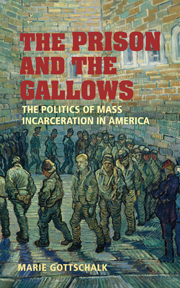Book contents
- Frontmatter
- Contents
- List of Figures and Table
- Preface and Acknowledgments
- 1 The Prison and the Gallows: The Construction of the Carceral State in America
- 2 Law, Order, and Alternative Explanations
- 3 Unlocking the Past: The Nationalization and Politicization of Law and Order
- 4 The Carceral State and the Welfare State: The Comparative Politics of Victims
- 5 Not the Usual Suspects: Feminists, Women's Groups, and the Anti-Rape Movement
- 6 The Battered-Women's Movement and the Development of Penal Policy
- 7 From Rights to Revolution: Prison Activism and the Carceral State
- 8 Capital Punishment, the Courts, and the Early Origins of the Carceral State, 1920s–1960s
- 9 The Power to Punish and Execute: The Political Development of Capital Punishment, 1972 to Today
- 10 Conclusion: Whither the Carceral State?
- Notes
- Select Bibliography
- Index
- Titles in the Series
3 - Unlocking the Past: The Nationalization and Politicization of Law and Order
Published online by Cambridge University Press: 05 September 2012
- Frontmatter
- Contents
- List of Figures and Table
- Preface and Acknowledgments
- 1 The Prison and the Gallows: The Construction of the Carceral State in America
- 2 Law, Order, and Alternative Explanations
- 3 Unlocking the Past: The Nationalization and Politicization of Law and Order
- 4 The Carceral State and the Welfare State: The Comparative Politics of Victims
- 5 Not the Usual Suspects: Feminists, Women's Groups, and the Anti-Rape Movement
- 6 The Battered-Women's Movement and the Development of Penal Policy
- 7 From Rights to Revolution: Prison Activism and the Carceral State
- 8 Capital Punishment, the Courts, and the Early Origins of the Carceral State, 1920s–1960s
- 9 The Power to Punish and Execute: The Political Development of Capital Punishment, 1972 to Today
- 10 Conclusion: Whither the Carceral State?
- Notes
- Select Bibliography
- Index
- Titles in the Series
Summary
“History is like waves lapping at a cliff. For centuries notunlocking the pasthing happens. Then the cliff collapses.”
– Henry SeeCriminal justice politics and policies have been a major, not a minor, theme in American political development. It is striking how often public officials throughout U.S. history have latched on to the crime and punishment issue to further their own political agendas and fortunes. Numerous national figures and presidential aspirants, from Thomas Jefferson to Theodore Roosevelt to Joseph McCarthy, played the crime card long before Barry Goldwater highlighted the issue in the 1964 presidential campaign. Furthermore, while direct federal involvement in crafting penal policy was minor and intermittent for much of U.S. history, the federal government did step in at key junctures (often by orchestrating or responding to national campaigns organized around crime-related concerns) that had important long-term consequences for the development of the carceral state.
These periodic campaigns, undertaken when criminal justice and law enforcement institutions were undeveloped, habituated Americans to indulge rhetorically in a politics of moralism that was not that costly for a long time. Americans could use penal politics to indulge their moralism and express their fears and anxieties because, while their law-and-order campaigns had enormous symbolic significance, the skeletal law enforcement apparatus checked their actual consequences. This is not to minimize the enormous consequences these campaigns had for some individuals, be they the 20 people hanged in the Salem witch trials in 1692 or the 30,000 women rounded up during World War I on suspicion of prostitution.
- Type
- Chapter
- Information
- The Prison and the GallowsThe Politics of Mass Incarceration in America, pp. 41 - 76Publisher: Cambridge University PressPrint publication year: 2006
- 1
- Cited by

